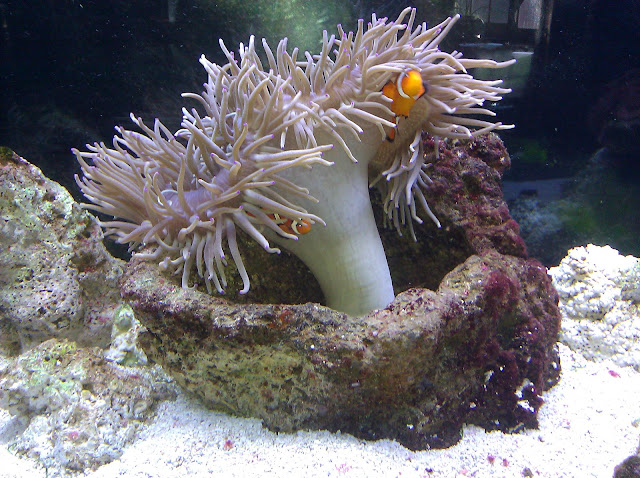As before, I have 3 visible aiptasia. Two on the left side of the Star Polyp Coral and one on the back of the anemone's bowl. I witnessed the Peppermint Shrimp on the back of the bowl last night and noticed the aiptasia wasn't visible. But I wasn't sure if I just couldn't see it due to the Moonlight LEDs.
I checked again this morning once the actinics kicked in, and I'm pretty sure it's gone. I'll double check later on in the week, but I think the shrimp just started paying rent.
Parts of the anemone didn't look so hot when I got home. It's left quarter appeared deflated, though the remainder of it looked very nice and healthy. I went ahead and hand-fed it. It didn't close up on me though. And then a bit later the mama Clown fish began to eat what I had put near it's mouth.
Maybe I should quit stressing about the anemone and just let the clowns take care of it. The previous owners said they never lifted a finger for it. I think I'm game to try that for a week or two. I'll watch to see if the Clowns feed the anemone. If the path of least resistance gets me to my goal quicker, why not?
I was thinking last night what I'm going to do if that thing ever splits... it HUGE. It's gotta be 10-12" in diameter. Hopefully I'll be one of the lucky one's in which the 2nd anemone resides close to the original - meaning it split for good reasons, not for bad.
Since I now have a phosphate test kit, I tested my tap water. No phosphates. There are probably other things in the water that don't need to be, but at least I feel assured I'm not adding to the phosphate levels in the tank by using tap water. That only leaves food as the source of new phosphates, and I've never been accused of starving fish, so I could get that under more control easily.
I find it strange, though, that after the last water change I had 0 phosphates. The next day I'm at about .125 ppm, and so far it's just plateaued from there. I'm beginning to think my rock is the primary source of phosphates in the water since it reappeared then leveled off. If it were food, it would steadily increase every day. We'll see what it's at before the next water change, which is in 5 days.
My hypothesis is that if the level of phosphates is still .125, my feedings are having a negligible impact on phosphates, meaning the levels are coming from the rock and substrate. Or at least the diatom and cyanobateria are keeping up with food phosphates.
I'm a ways off from doing anything big with the tank, if ever. I'm asking myself "what's my biggest problem in the tank?". Hard to say right now, since I don't perceive the tank as having a major AND permanent problem. Sure the diatoms and cyanobacteria are annoying, but they will pass. It's like the tank has started another cycle since I added that last 15 lbs of rock. Then more inhabitants came before that cycle ended and I'm back to square one. So time should heal the brown and red colors. Easy - time is free.
The next biggest issues I see are tied. Nitrate levels, Ammonia levels, and phosphate levels.
Ammonia levels will eventually work themselves out. Given enough time, the proper bacteria will grow to meet the demand of ammonia levels. Once again, time is my friend.
Nitrate and phosphate levels will probably always be around either from food or from rock. I know some believe macroalgae to be a bandaid (myself included), but exporting nutrients via micro or macroalgae is a legitimate practice (
just one of many sources). The key is to actually export it via harvesting, not to let the macroalgae grow to the size of a basketball... and I think that's where I become seemingly hypocritical. I agree with it's use as long as it's harvested (removed), but not with it's presence for the sake of presence.
So perhaps the next thing I'll do is devise a rod on a suction cup to pin the chaeto to the side of the tank. If it's mounted in the right spot close to a powerhead, it will spin. Who knows...
And with the phosphates and nitrates being taken in by macroalgae, perhaps my browns and reds will dissipate sooner.
(I'm still back and forth about adding pods to the chaeto)























































